United Kingdom European Communities membership referendum, 1975
| United Kingdom European Community (Common Market) membership referendum | ||||||||||||||||||||||
|---|---|---|---|---|---|---|---|---|---|---|---|---|---|---|---|---|---|---|---|---|---|---|
|
The Government has announced the results of the renegotiation of the United Kingdom's terms of membership of the European Community. Do you think the United Kingdom should stay in the European Community (the Common Market)? | ||||||||||||||||||||||
| Location | United Kingdom | |||||||||||||||||||||
| Date | June 5, 1975 | |||||||||||||||||||||
| ||||||||||||||||||||||
| ||||||||||||||||||||||
| Referendum held: 5 June 1975 | ||||||||||||||||||||||
| Part of a series of articles on the |
| United Kingdom in the European Union |
|---|
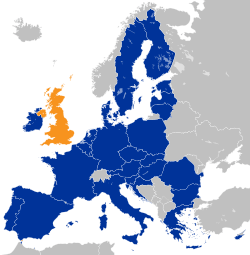 |
|
Membership
Legislation |
|
The United Kingdom EC referendum of 1975, also known as the Common Market referendum and EEC membership referendum was a referendum held on 5 June 1975 in the United Kingdom to gauge support for the country's continued membership of the European Communities (EC), often known as the Common Market at the time, which it had entered in 1973 under the Conservative government of Edward Heath. Labour's manifesto for the October 1974 general election promised that the people would decide "through the ballot box"[1] whether to remain in the EEC. The electorate expressed significant support for EEC membership, with 67% in favour on a national turnout of 64%. The referendum result was not legally binding due to the concept of Parliamentary sovereignty. However, it was widely accepted that the vote would be the final say on the matter. In a 1975 pamphlet, then Prime Minister Harold Wilson said: "[. . .] I ask you to use your vote. For it is your vote that will now decide. The Government will accept your verdict."[2] The pamphlet also said: "Now the time has come for you to decide. The Government will accept your decision - whichever way it goes." This was the first referendum held throughout the entire United Kingdom, and remained the only UK-wide referendum until the 2011 referendum on alternative voting was held thirty-six years later.
The February 1974 general election yielded a Labour minority government, which then won a majority in the October 1974 general election. Labour pledged in its February 1974 manifesto to renegotiate the terms of British accession to the EEC, and then to consult the public on whether Britain should stay in the EEC on the new terms, if they were acceptable to the government. The Labour Party had historically feared the consequences of EEC membership, such as the large differentials between the high price of food under the Common Agricultural Policy and the low prices prevalent in Commonwealth markets, as well as the loss of economic sovereignty and the freedom of governments to engage in socialist industrial policies, and party leaders stated their opinion that the Conservatives had negotiated unfavourable terms for Britain.[3] The EEC heads of government agreed to a deal in Dublin on 11 March 1975; Wilson declared, "I believe that our renegotiation objectives have been substantially though not completely achieved", and said that the government would recommend a vote in favour of continued membership.[4] On 9 April, the House of Commons voted 396 to 170 to continue within the Common Market on the new terms. Along with these developments, the government drafted a Referendum Bill, to be moved in case of a successful renegotiation.
The referendum debate was an unusual time in British politics. During the campaign, the Labour Cabinet was split and its members campaigned on each side of the question, a rare breach of Cabinet collective responsibility. Most votes in the House of Commons in preparation for the referendum were only carried thanks to opposition support, and the Government faced several defeats on technical issues such as election counts. Finally, although the Government declared in advance that it would comply with to the result, the referendum itself was not legally binding upon the government.
Background


In 1952, when the European Coal and Steel Community was instituted, the United Kingdom decided not to become a member. The UK was still absent when the Treaty of Rome was signed, creating the European Economic Community (the Common Market). However, in the late 1950s the Conservative government of Harold Macmillan dramatically changed its attitude and appointed Edward Heath, later prime minister, to submit an application and lead negotiations for Britain to enter the Common Market. But at a meeting in January 1963 the French president Charles de Gaulle rebuffed and vetoed Macmillan's request to join the Common Market. Despite the veto, Britain restarted talks with the EEC in 1967; and in April 1970, during the 1970 general election campaign, Edward Heath said that further European integration would not happen "except with the full-hearted consent of the Parliaments and peoples of the new member countries".[5] Heath became Prime Minister, and personally led many of the negotiations: he struck up a friendship with the new French president Georges Pompidou who oversaw the lifting of the veto, which paved the way for UK membership. No referendum was held when Britain agreed to an accession treaty on 22 January 1972 together with the EEC states, Denmark, and Ireland, or when the European Communities Act 1972 went through the legislative process. Britain joined the European Economic Community on 1 January 1973, along with Denmark and Ireland. This later became the European Union.
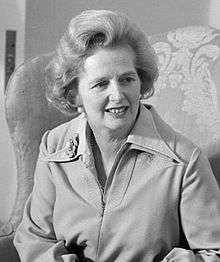
Throughout this period, the Labour Party was divided, both on the substantive issue of EEC accession and on the question of whether accession ought to be approved by referendum. In 1971, pro-Market figures like Roy Jenkins, the Deputy Leader of the Labour Party, said a Labour government would have agreed to the terms of accession secured by the Conservatives.[3] However, the National Executive Committee and the Labour Party Conference disapproved of the terms. In April 1972, the anti-Market Conservative MP Neil Marten tabled an amendment to the European Communities Bill which called for a consultative referendum on entry. Labour had previously opposed a referendum, but the Shadow Cabinet decided to support Marten's amendment. Jenkins resigned as Deputy Leader in opposition to the decision, and many Labour MPs abstained on the division.
At the February 1974 general election, Labour's manifesto promised renegotiation of Britain's terms of membership, to be followed by a consultative referendum on continued membership under the new terms if they were acceptable.[6] In the October 1974 manifesto, this was changed to the promise that Labour would "give the British people the final say, which will be binding on the Government – through the ballot box – on whether we accept the terms and stay in or reject the terms and come out."[1] This could be interpreted as including the option of an election in 1975;[3] however, Labour won a working majority, and had no need of another general election.[7]
The government introduced a bill which became the Referendum Act 1975. Prior to this bill's passing there was no procedure or legislation within the United Kingdom for holding any such plebiscite. The vote, the only nationwide plebiscite to be held in the UK during the 20th century, was of constitutional significance. Referendums had been widely opposed in the past on the grounds that they violated the principle of parliamentary sovereignty. The first major referendum to be held in any part of the UK had been the Northern Ireland sovereignty referendum, 1973.[8] The government favoured a single national count of votes; the Liberal Party favoured individual counts in each parliamentary constituency; however, the majority in the House of Commons voted for counts by administrative regions (the post 1974 county council areas).[3] The Act did not specify any supermajority of "Yes" votes for approval of the terms; a simple majority would suffice to win the vote.[9]
Referendum question
The question to be asked to the British electorate that was set out within the legislation was:
The Government has announced the results of the renegotiation of the United Kingdom's terms of membership of the European Community.
Do you think that the United Kingdom should stay in the European Community (the Common Market)?
permitting a simple YES / NO answer (to be marked with a single (X)).
The referendum took place 25 years before the passing of the Political Parties, Elections and Referendums Act 2000 by the then Labour Government of Tony Blair which set into British law a general procedure for the holding of a UK-wide referendum with the creation of the Electoral Commission, which now oversees such votes.
Party support
The referendum was called in April 1975. Since Prime Minister Harold Wilson's cabinet was split between supporters and opponents of the Common Market, and since members of each side held their views strongly, he made the decision, unprecedented outside coalition government, to suspend the constitutional convention of Cabinet collective responsibility. Cabinet members would be allowed to publicly campaign against each other. In total, seven of the twenty-three members of the cabinet opposed EEC membership.[10] Wilson's solution was that ministers speaking from the despatch box would reflect government policy, i.e. support for EEC membership, but that they would be allowed to speak freely otherwise. This compromise avoided mass dismissals of Cabinet ministers, with only Eric Heffer among all government ministers being obliged to resign, due to his speaking against EEC membership in the House of Commons.
Yes campaign (Britain In Europe)
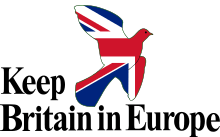
The "Yes" campaign was officially supported by Wilson's Government[11] and the majority of his cabinet, including the holders of the three other Great Offices of State: Denis Healey, the Chancellor of the Exchequer; James Callaghan, the Foreign Secretary; and Roy Jenkins, the Home Secretary. It was also supported by the majority of the Conservative Party including its newly elected leader Margaret Thatcher—249 of 275 party members in Parliament supported staying in Europe in a free vote in April 1975[11]—the Liberal Party, the Social Democratic and Labour Party, the Alliance Party of Northern Ireland and the Vanguard Unionist Progressive Party.
No campaign (National Referendum Campaign)
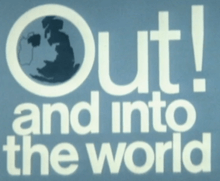
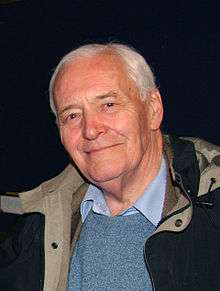
The influential Conservative Edward du Cann said that "the Labour party is hopelessly and irrevocably split and muddled over this issue".[11] The "No" campaign included the left wing of the Labour Party, including the cabinet ministers Michael Foot, Tony Benn, Peter Shore, Eric Varley, and Barbara Castle who during the campaign famously said "They lured us into the market with the mirage of the market miracle". Some Labour "No" supporters, including Varley, were on the right wing of the party, but most were from the left. The No campaign also included a large number of Labour backbenchers; upon the division on a pro-EEC White Paper about the renegotiation, 148 Labour MPs opposed their own government's measure, whereas only 138 supported it and 32 abstained.[3]
"Many Conservatives feel the European Community is not good for Britain ... The Conservative party is divided on it too", du Cann—head of the Conservatives' 1922 Committee—added,[11] although there were far fewer Eurosceptic figures in the Parliamentary Conservative Party in 1975 than there would be during later debates on Europe, such as the accession to the Maastricht Treaty. Most of the Ulster Unionist Party were for No in the referendum, most prominently the former Conservative minister Enoch Powell, who after Benn was the second most prominent anti-Marketeer in the campaign.[12] Other parties supporting the "No" campaign included the Democratic Unionist Party, the Scottish National Party, Plaid Cymru, and parties outside Parliament including the National Front and the Communist Party of Great Britain.
Official party positions
Conservative and Liberal Party conferences consistently supported EEC membership for several years up to 1975. At a Labour Party conference on 26 April 1975, the Labour membership rejected continuing EEC membership by almost a 2:1 margin. Tony Benn said "We have had a conference and the decision is clear ... It is very clear that there now must be a move for the Labour Party to campaign." The majority of the Labour Party leadership was strongly for continuing membership, and the margin of the party vote was not a surprise, since only seven of forty-six trade unions present at the conference supported EEC membership. Prior to the conference, the party had decided that if the conference voted by a margin of 2:1 or more in favour of a particular option, it would then support that position in the referendum campaign. Otherwise, the "party machine" would remain neutral. Therefore, the Labour Party itself did not campaign on either side.
The campaign, funding and media support
The government distributed pamphlets to every household in Britain written by the official Yes and No campaigns, together with its own pamphlet which argued in support of EEC membership.[13] According to this pamphlet, "the most important (issues in the renegotiation) were FOOD and MONEY and JOBS".
During the campaign, almost the entirety of the mainstream national British press supported the "Yes" campaign. The left-wing Morning Star was the only notable national daily to back the "No" campaign. Television broadcasts were used by both campaigns, like party political broadcasts during general elections. They were broadcast simultaneously on all three terrestrial channels: BBC 1, BBC 2 and ITV. They attracted audiences of up to 20 million viewers. The "Yes" campaign advertisements were thought to be much more effective, showing their speakers listening to and answering people's concerns, while the "No" campaign's broadcasts featured speakers reading from an autocue.
The "Yes" campaign enjoyed much more funding, thanks to the support of many British businesses and the Confederation of British Industry. According to the treasurer of the "Yes" campaign, Alastair McAlpine, "The banks and big industrial companies put in very large sums of money". At the time, business was "overwhelmingly pro-European",[14] and Harold Wilson met several prominent industrialists to elicit support. It was common for pro-Europeans to convene across party and ideological lines with businessmen.[14] John Mills, the national agent of the "No" campaign, recalled: "We were operating on a shoe-string compared to the Rolls Royce operation on the other side".[15] However, it was also the case that many civil society groups supported the "Yes" campaign, including the National Farmers Union and some trade unions.
Much of the "Yes" campaign focused on the credentials of its opponents. According to Alastair McAlpine, "The whole thrust of our campaign was to depict the anti-Marketeers as unreliable people – dangerous people who would lead you down the wrong path ... It wasn't so much that it was sensible to stay in, but that anybody who proposed that we came out was off their rocker or virtually Marxist.".[15] Tony Benn controversially claimed: "Half a million jobs lost in Britain and a huge increase in food prices as a direct result of our entry into the Common Market",[14] using his position as Industry Minister as an authority. His claims were ridiculed by the "Yes" campaign and ministers; the Daily Mirror labelled Benn the "Minister of Fear", and other newspapers were similarly derisive. Ultimately, the "No" campaign lacked a popular, moderate figure to play the public leadership role for their campaign that Jenkins and Wilson fulfilled in the "Yes" campaign.
Counting areas
The referendum was held nationally across all four countries of the United Kingdom as a single majority vote in 68 counting areas under the provisions of the Referendum Act 1975 to which the then administrative counties of England and Wales and the then administrative regions of Scotland were used with Northern Ireland as a single counting area.
The following table shows the breakdown of the voting areas for the referendum within the United Kingdom.
| Country | Counting areas |
|---|---|
| United Kingdom | Referendum declaration ; 68 counting areas |
| Constituent countries | Counting areas |
|---|---|
| England | 47 counting areas |
| Northern Ireland | Single counting area |
| Scotland | 12 counting areas |
| Wales | 8 counting areas |
Result

Voting in the referendum took place across the United Kingdom on Thursday 5 June between 0700 and 2200 BST. All counting areas started their counts the following day on Friday 6 June at 0900 BST. The final result was announced late on Friday 6 June 2016 just before 2300 BST by the Chief counting officer (CCO) Sir Phillip Allen at Earls Court Exhibition Centre in London after all 68 counting areas had declared their totals. With a national turnout of 64% across the United Kingdom the target to secure the majority win for the winning side was 12,951,598 votes. The decision by the electorate was a decisive "Yes" to continued EEC membership which won by a huge majority of 8,908,508 votes (34.5%) over those who had voted "No" to reject continued membership.
In total, over two-thirds of voters supported continued EEC membership. 67.2 percent voted Yes and 32.8 percent voted No. At council level, support for EEC membership was positively correlated with support for the Conservative Party and with average income. In contrast, poorer areas that supported Labour gave less support to the question. Approval was well above 60% in almost every council area in England and Wales, with the strongly Labour-supporting Mid Glamorgan being the exception. Scotland and Northern Ireland gave less support to the question than the British average. Once the voting areas had declared, their results were then relayed to the Chief counting officer Sir Philip Allen who later declared the final result.
All the counting areas within the United Kingdom returned large majority votes in favour of "Yes", except the two Scottish regions of the Shetland Islands and the Western Isles which returned majority votes in favour of a "No" vote.
| Choice | Votes | % |
|---|---|---|
| |
17,378,581 | 67.23 |
| No | 8,470,073 | 32.77 |
| Valid votes | 25,848,654 | 99.79 |
| Invalid or blank votes | 54,540 | 0.59 |
| Total votes | 25,903,194 | 100.00 |
| Registered voters and turnout | 40,456,877 | 64.03 |
| Yes: 17,378,581 (67.2%) |
No: 8,470,073 (32.8%) | ||
| ▲ | |||
Results by constituent countries
| Constituent country | Votes | Proportion of votes | ||
|---|---|---|---|---|
| Yes | No | Yes | No | |
| England | 14,918,009 | 6,812,012 | 67.8% | 32.2% |
| Wales | 869,135 | 472,071 | 64.8% | 35.2% |
| Scotland | 1,332,186 | 948,039 | 58.4% | 41.6% |
| Northern Ireland | 259,251 | 237,911 | 52.1% | 47.9% |
TV coverage
Both the BBC and ITV provided coverage throughout the following day and the BBC programme was presented by David Dimbleby and David Butler. There were several programmes throughout the day. Part of the coverage was repeated to mark the 30th anniversary of the referendum in June 2005, and was also shown to mark the 40th anniversary in June 2015 on the BBC Parliament channel and will be shown again to mark the 41st anniversary ahead of the 2016 EU Referendum.[18]
Reactions and consequences
On Friday 6 June 1975 at 1830 BST the Prime Minister Harold Wilson gave his reaction outside 10 Downing Street as counting continued through the result was clear by this point:
"The verdict has been given by a vote with a bigger majority than has been received by any Government in any general election. Nobody in Britain or the wider world should have any doubt about its meaning. It was a free vote, without constraint, following a free democratic campaign conducted constructively and without rancour. It means that fourteen years of national argument are over. It means that all those who have had reservations about Britain’s commitment should now join wholeheartedly with our partners in Europe, and our friends everywhere to meet the challenge confronting the whole nation."
Roy Jenkins said "It puts the uncertainty behind us. It commits Britain to Europe; it commits us to playing an active, constructive and enthusiastic role in it." Tony Benn said "When the British people speak everyone, including members of Parliament, should tremble before their decision and that's certainly the spirit with which I accept the result of the referendum."[19]
The result strengthened Harold Wilson's tactical position, by securing a further post-election public expression of support for his policies. According to Cook and Francis (1979), "The left of his party had been appeased by the holding of a referendum, the right by its result".[3] Following the result, the Labour Party and British trade unions themselves joined European institutions, such as the Socialist Group in the European Parliament, to which they had been reluctant to commit before public approval of EEC membership.
In the House of Commons, the issue of Europe had been effectively settled for two years, until the debate about direct elections to the European Parliament began in 1977.
The result would go on to provide a major pro European mandate to politicians particularly in the UK Parliament for the next forty one years until the 2016 EU Referendum when the United Kingdom voted by 51.9% to 48.1% to leave the European Union, where the results were reversed - with England and Wales voting to leave, whilst Scotland, Northern Ireland and London voted to stay.
Thirty-year rule
The question of sovereignty was discussed in an internal document of the Foreign and Commonwealth Office (FCO 30/1048) before the European Communities Act 1972, but was not available to the public until January 2002 under the Thirty-year rule. Among "Areas of policy" listed "in which parliamentary freedom to legislate will be affected by entry into the European Communities" were: Customs duties, Agriculture, Free movement of labour, services and capital, Transport, and Social Security for migrant workers. The document concluded (paragraph 26) that it was advisable to put the considerations of influence and power before those of formal sovereignty.[20]
See also
- Brexit
- Referendums in the United Kingdom
- United Kingdom general election, February 1974
- United Kingdom general election, October 1974
- Withdrawal from the European Union
- United Kingdom European Union membership referendum, 2016
Further reading
- Booker, C., and North, R., The Great Deception, Continuum Publishing London and New York, 2003. (EU Referendum Edition published by Bloomsbury Publishing PLC, April 2016)
References
- 1 2 The Labour Party (1974). Britain will win with Labour: Labour Party manifesto, October 1974. Retrieved 26 November 2009.
- ↑ http://www.harvard-digital.co.uk/euro/pamphlet.htm
- 1 2 3 4 5 6 Cook, Chris; Francis, Mary (1979). The first European elections: A handbook and guide. London: Macmillan Press. ISBN 0-333-26575-0.
- ↑ "European Community". Parliamentary Debates (Hansard). House of Commons. 18 March 1975. col. 1456–1480.
- ↑ Teodorczuk, Thomas. "Ultimate Vindication: The Spectator and Europe 1966–79". Bruges Group Papers. The Bruges Group (43). Archived from the original on 9 October 2009. Retrieved 26 November 2009.
- ↑ The Labour Party (1974). Let us work together: Labour's way out of the crisis: Labour Party manifesto, February 1974. Retrieved 26 November 2009.
- ↑ Williamson, Adrian (5 May 2015). "The case for Brexit: lessons from the 1960s and 1970s". History & Policy. History & Policy. Retrieved 13 July 2016.
- ↑ Bogdanor, Vernon (2009). The New British Constitution. Oxford: Hart Publishing. ISBN 978-1-84113-671-4.
- ↑ Gay, Oonagh; Foster, David (25 November 2009). "Thresholds in Referendums" (PDF). London: House of Commons Library. Retrieved 8 September 2010.
- ↑ The seven Common Market opponents in the Cabinet were Michael Foot (Employment), Tony Benn (Industry), Peter Shore (Trade), Barbara Castle (Social Services), Eric Varley (Energy), William Ross (Scotland) and John Silkin (Planning and Local Government).
- 1 2 3 4 "Conservatives favor remaining in market". Wilmington Morning Star. UPI. 4 June 1975. p. 5. Retrieved 26 December 2011.
- ↑ David Butler and Uwe Kitzinger, The 1975 Referendum (Macmillan, 1976), p. 178, p. 194.
- ↑ HM Government (1975). Britain's new deal in Europe. Retrieved 26 November 2009.
- 1 2 3 Cockerell, Michael (4 June 2005). "How we were talked into joining Europe". The Independent. London. Retrieved 26 November 2009.
- 1 2 Cockerell, Michael (4 June 2005). "How Britain first fell for Europe". BBC News. London. Retrieved 26 November 2009.
- ↑ "Research Briefings - The 1974-75 UK Renegotiation of EEC Membership and Referendum". House of Commons Library.
- ↑
- ↑ "BBC One London - 6 June 1975 - BBC Genome". Genome.ch.bbc.co.uk. Retrieved 2016-06-07.
- ↑ "1975: UK embraces Europe in referendum". BBC on This Day. London. 6 June 1975. Retrieved 26 November 2009.
- ↑ FCO 30/1048, Legal and constitutional implications of UK entry into EEC (open from 1 January 2002.
External links
| Wikimedia Commons has media related to United Kingdom European Communities membership referendum, 1975. |
- Full text of the accession act
- Transcript of government pamphlet advocating to vote to stay in the EEC
- Article "Jan-Henrik Meyer, The 1975 referendum on Britain's continued membership in the EEC" on CVCE website
- BBC coverage of the Referendum on YouTube
- Adrian Williamson, The case for Brexit: lessons from the 1960s and 1970s, History and Policy (2015).
- Article "Andrew Glencross (2015), Looking Back to Look Forward: 40 Years of Referendum Debate in Britain"
